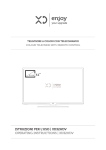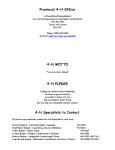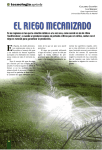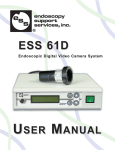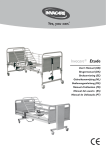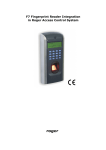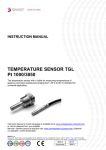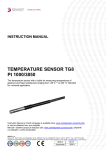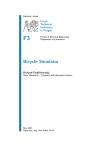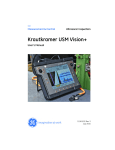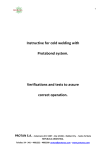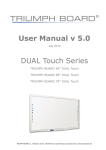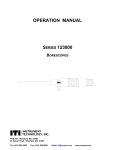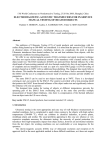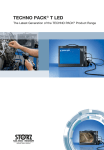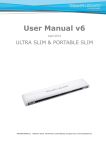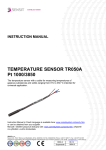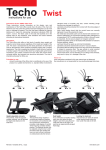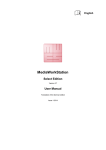Download technical condition detection of air tanks in the army of the czech
Transcript
Science & Military 1/2012 TECHNICAL CONDITION DETECTION OF AIR TANKS IN THE ARMY OF THE CZECH REPUBLIC Jan FURCH, Josef GLOS, Ondřej RAZÝM Abstract: The aim of the paper was to make a methodology used for performing the air tank inspections of combat and special vehicles in the Army of the Czech Republic. The main asset of the methodology is introducing a suitable ultrasound gauge which would be able to take measures without removing a coating. After taking a lot of measures and comparing single gauges accuracy we came to a conclusion that the most convenient device is the DM 4 DL ultrasound thickness gauge. This device is suitable namely for finding out the wall thickness of non-dismountable air tanks. Keywords: Technical condition of air tanks. Air tank inspection. 1 INTRODUCTION 2.1 Technological procedure I First, it would be desirable to specify the term “air tank” and clarify the way of performing air tank inspection in the Army of the Czech Republic. The vehicle air tank is a special kind of a stable pressure tank which serves as compressed air storage used for controlling some motor vehicle equipment, trailers and special equipment [1]. No later than every five years since the last inspection the air tank inspection is provided by inspecting certified personnel who observe “The Obligatory Guideline, the evidence number TZ 1/2000 SOTD”. The air tank inspection itself consists of the following tasks: The technological procedure I consists of four main parts. The first part is the shortest one and includes information on taking an air tank by inspecting certified personnel. The air tank is supposed to be clean and labelled. On the label there should be put a battalion number, a vehicle type and the year of vehicle manufacture, and a military number plate. The second part deals with carrying out an external check during which a coating is examined. The coating should be clean and intact (with no cracks, fragments or hammer-marks). Next, case geometric shape requirements are determined with the maximum deviation 2 mm. The third part describes the interior inspection of an air tank. First, the inner space of the air tank should be cleaned of impurities and sediments. Then, using and endoscope, the walls should be examined. The aim of the inspection is to find out whether there are cracks on the walls, or if an inner coating is intact, if there is corrosion there, and what the state of the most stressed spots is (edges, welding joints, etc.). When having reason to believe that there are cracks, a capillary test will be performed. Also a colour defectoscopy might be applied which is rather advanced technological procedure. If there are cracks or disintegration of a material due to corrosion, the air tank is examined with Technological procedure II, or is disposed straight away. The fourth step to be taken is a pressure test. First, the air tank is filled with water. Then, overpressure corresponding with operation overpressure (nominal value stated on a tank label) is created in the tank with a hand pump. Finally by tapping weld joints with a little hammer (the hammer mass is specified by a particular standard) air tank tightness is checked. If no leakage is present, the overpressure will be increased to a test value (1,5 times the amount of a nominal value) and this overpressure is left in the tank till it is examined (at least for 3 minutes). After the test has been completed, we let the water out and the air tank dry up. [2]. • • • • external examination and the check of coating, internal inspection and the check of coating, a pressure test, a tightness test [1]. After the air tank is mounted back on a vehicle, the tightness test will be performed only if the pressure test has been satisfactory, and the aim of it is to check the tightness of dismantleable joints. If we have reason to believe during the inspection that the wall of an air tank is thinner (because of corrosion for example), we proceed to check wall thickness with an ultrasonic thickness gauge and calculate strength (following Technological Procedure II) [1]. Air tank operation check is performed at least once a year and during this checking an air tank label and air tank condition is visually examined, and also sludge is removed from the air tank [1]. 2 TECHNOLOGICAL PROCEDURES OF PERFORMING INSPECTIONS In the Army of the Czech Republic there have been made two technological procedures. Technological procedure I is a basic document for providing air tank inspections. Technological procedure II is used only when little cracks or corrosion is found during air tank inspection, or an air tank´s label is missing or illegible. 87 Science & Military 1/2012 The last step which is to be taken is renewing an air tank coating, punching a test date, the next test date and an inspecting certified personnel evidence number on an air tank label (in case the test was successful – no leakage, cracks, or permanent deformities were found). Test results will be recorded in the book of revisions of an air tank revision station. 2.2 Technological procedure II Technological procedure II is divided into six parts. The first three parts are the same as in the Technological procedure I. Te fourth part describes the way of checking wall thickness with an ultrasonic thickness gauge. The checking is performed in the areas where corrosion was found during inner examination, while observing relevant standards (ČSN 015021 and ČSN 583-1,2,3). The identified value of the smallest wall thickness is later used during proof calculations. The fifth part deals with a proof strength calculation. The calculation follows the standard ČSN 69 0010. Basic calculations are done for a cylinder case and a torospherical bottom and they are used for counting an allowed number of working cycles and specifying the date of the next air tank inspection. The sixth part of the Technological procedure is the same as the fourth one of the Technological procedure. 2.3 Inspection of non-dismountable air tanks The previous two technological procedures describe the inspections of air tanks which are removed from a vehicle before the actual inspection. However, in the Army of the Czech Republic there are vehicles, the construction of which makes the dismantling of air tanks impossible, or the dismantling would be expensive and uneconomic. So the air tank inspection of such vehicles is to be tackled in a different way. When inspecting these air tanks, we focus mainly on careful external examination. In the air tanks with an accessible cleaning valve it is desirable to perform inner inspection with a fibroscope. Following the inner inspection we check wall thickness in corroded areas using an ultrasonic thickness gauge. Before the check is carried out, it is necessary to remove a coating in order to make the measurement accurate. If the air tank is not equipped with an accessible cleaning valve, which means that it cannot be examined with a fibroscope, other air tanks which have been already checked will serve as the basis of determining its condition. After the measurement with an ultrasonic thickness gauge has been completed, braking system will be put into operating state, and by increasing the overpressure to the highest operating value (by a pressure gauge in a 88 driver´s cab), the tightness will be checked, and then the measurement of critical places will be performed again using the ultrasonic thickness gauge. Finally the air tanks´ condition will be evaluated. Air tanks cannot show signs of misuse, deformation, ruptured welded joint, bumps, the coating has to be compact. The inner part of an air tank can be corroded on the surface. But there cannot be point or inter-crystal corrosion there. The air tanks have to be tight during the highest operation overpressure, and when checking thickness with an ultrasonic thickness gauge, it cannot decrease by more than 5 percent. 3 METHODOLOGY PLAN TO FIND OUT TECHNICAL CONDITION OF AIR TANKS A methodology plan is based on original technological procedures and the results of the performed accuracy measuring of the ultrasonic thickness gauge DM 4 DL. This gauge is considered to be the most suitable. There is a dual probe in this ultrasonic thickness device which means that a pulse reflection measuring method is applied, see Fig. 1. The device is compact and small sized having a robust case. It is supplied by two AA alkaline batteries providing up to 200 hrs of use. Dialog probes resolution, V path error correction (compensates for non-linearity of dual element probes), zero point adjusting and ultrasonic flow rectification are performed automatically by the gauge. The measuring range is from 0,5 mm to 500 mm, the displayed resolution ranges from 0,01 mm for the thickness of 99,99 mm, and 0,1 mm for the thickness more than 99,99 mm. The period of adjustable ultrasonic wave velocity ranges from 1000 ms-1 up to 9999 ms-1. The receiver bandwidth is from 300 kHz to 10 MHz (amplification setting is three-levelled – automatic, high and low). The measurement update rate is 4 Hz, but it increases up to 25 Hz in a minimum capture mode. [2]. Transmitter Receiver Filtering Filtering Piezo-changer Piezo-changer Partition Case Case Underlying material Fig. 1 Parts of a dual probe [6] When measuring the thickness with the reflection method Dual-Multi, the ultrasonic wave is sent into Science & Military 1/2012 the material under test (gel is used as a contact material/interface between the probe and the material under test) and travels through the material until it encounters an interface, that is a material with different physical characteristics, such as air, paint, corrosion, etc. At the interface the pulse is reflected back to the probe, see Fig. 2. We also measure the time needed for the wave to make this round trip. If we know the velocity of ultrasound proliferation in the environment c, it is possible to calculate the thickness of the material under test with the following equation (1). The DA 451 is a commonly used dual probe. Its measuring range is from 1,2 to 200 mm, and contact diameter is 12,5 mm. The curvature of the surface to be measured with the probe should be at least 15 mm. Probe frequency is 5 MHz and accuracy ± 0,05 mm. The DA 312 B16 is a special miniature probe with a measuring range from 0,6 to 25 mm of 10 MHz frequency. Since the contact diameter is 3 mm, the probe is used for measuring very small radii and hole corrosion [4]. 3.1 Plan of air tank methodological procedure Probe Coating Test material c Corrosion layer s; t Fig. 2 The way of measuring thickness with the DM 4 DL gauge applying the Dual-Multi method A mathematical expression of the thickness of the material under test is as follows [3]: s= c ⋅t [m] n (1) where: s .....is the thickness of the material under test, c ..... is the velocity of ultrasound proliferation in specific environment, t ...... is the time for the ultrasonic wave to make its round trip, n ..... is a number of wave passages through the object under test. In a common military environment are used simple ultrasonic thickness gauges which are calibrated to the ultrasound wave velocity typical for steel, which is 5920 ms-1. More complex gauges, such as DM 4 DL, enable the velocity to be changed flexibly depending on the structure of the material to be measured. A probe is an essential part of each ultrasonic thickness gauge. When measuring, two probes DA 451 (Fig. 3) and DA 312 B16 (Fig. 4) were used. Fig. 3 Probe DA 451 Fig. 4 Probe DA 312 B16 Air tank demounting (only for the air tanks which might be demounted from a vehicle) and taking for inspection. An air tank is demounted from a vehicle and then taken for inspection. The air tank is to be free of dirt and provided with a label containing a device number, a type, the year of manufacture and a vehicle evidence number. In case the air tank cannot be demounted from a vehicle, the whole vehicle is taken. 1) Air tank demounting (only for the air tanks which might be demounted from a vehicle) and taking for inspection. An air tank is demounted from a vehicle and then taken for inspection. The air tank is to be free of dirt and provided with a label containing a device number, a type, the year of manufacture and a vehicle evidence number. In case the air tank cannot be demounted from a vehicle, the whole vehicle is taken. 2) Air tank preparation for inspection All valves and other parts will be removed from an air tank. If there is a label on the air tank which is not fastened enough, non-hermetically welded, or illegible, it will be replaced by a new one with the information taken from a service place revision book. The reason for removing the label is corrosion under the label which occurs rather frequently, because water and damp might get there (see Fig. 6). Next, all holes will be sealed and a surface will be cleaned depending on the amount of dirt. To clean it, organic solvents, such as petrol for technical use, paraffin oil and diesel are applied. As for nonflammable organic solvents, we use perchlorethylene, trichloroethylene, etc. Regarding alkaline water solutions, the cleaning agent of a Synalod production marking might be applied. If there is corrosion on the external side of an air tank, it can be removed either mechanically or chemically. To remove it mechanically, we use different brushes and sandpapers. In order to remove it chemically, we apply rust-removers like Rezol 2000, Loctite or Pragokor 100. As to the air tanks which cannot be dismounted from a vehicle, all the above operations 89 Science & Military 1/2012 will be performed the same way, but with an air tank placed on a vehicle. Fig. 5 Corrosion present under an air tank label 3) External air tank checking The prime aim of external check is to examine whether a coating stayed intact. The air tank cannot show signs of hammer blows, cracks or breaches. If we have reason to believe that there are cracks, it is necessary to carry out the check using a capillary test. The conditions of welding joints and deviations from air tank geometric shape are also examined. 4) Internal air tank checking When checking an internal tank, it is necessary to have the inner surface clean and free from impurities. If it is not, the surface is to be cleaned. After this, the visual inspection might be performed with a light viewer or an endoscope. Borescopes, fiberscopes and videoscopes work on the endoscope principle. The most up-to-date endoscopes are videoscopes which consist of a probe equipped with a miniature video camera. With software they enable us to quantify spotted defects. When performing the internal inspection, we concentrate on the presence of cracks, deformations, corrosion, the condition of bevelled spots and higher stress spots. Following the actual results, relevant measures will be taken. If there is reason to believe that there are cracks or corrosion, a capillary test will be performed and the spot will be checked with the DM 4 DL ultrasonic thickness gauge. 5) Air tank checking with an ultrasonic thickness gauge When checking air tanks with ultrasonic thickens gauge, it is highly recommended that the DM 4 DL is to be used. The biggest advantage of this gauge is its ability to measure through an external coating. The first step when using the gauge is the calibration of it, but since a standard calibration is impossible to make, all we can do is set the velocity of ultrasound waves in the material. At present the only alternative is to set the 5 920 ms-1 speed which is a speed for steal. But not all air tanks are made of the same material, therefore it would be advisable to develop a database containing speeds used for single air tanks. The database might be filled basically by two different ways. The first one is to get the information directly from the manufacturer, and the other one is to take the measurements of disposed air tanks. The air tanks will be cut in two and then, having gauge precise calibration, we will calculate ultrasound speed used later for measuring air tanks. 90 After the velocity is set, the areas which have been selected in advance will be measured. The areas will be chosen on the basis of internal check results. Generally, the most exposed areas are those at the bottom of an air tank, namely the ones close to cleaning valves, welded joints and under labels, as it has been mentioned before. The measurement is taken after presetting the function Dual-Multi (that means without removing the coating) by moving slowly the probe DA 451 along a critical area. The device can be set for a few modes. The most convenient mode is called differential measurement where a nominal thickness value is set by the user. Then, the areas which approximate this value or are of smaller values are searched for. Another option is the mode MIN which is used to capture the thinnest value. Using this way, the weakest areas of an air tank are found. They are marked by inspecting certified personnel and the measurement of these areas are taken with the DM 4 DL gauge in the THK mode. Each area is measured three up to five times. The mean value of the measuring is calculated and then the values as well as the point location are recorded in a measuring report. As for non-dismountable air tanks, it is determined that at the bottom part of an air tank the area of an imaginary rectangular, the length of which equals the air tank and the width equals one fifth of an air tank diameter value, will be checked by the DM 4 DL ultrasonic thickness gauge using the following formula: d= D [mm] 5 (2) where: d .... the width of an imaginary rectangular, D.... an air tank diameter. The thickness of an air tank wall must by no means drop below a critical thickness value which is determined as follows: d crit = 0,95 ⋅ d nom (3) where: d crit ...is critical air tank wall thickness, d nom ..is nominal air tank wall thickness. If the displayed value is not stabilized in the ± 0,02 mm range, it will be necessary to use the probe DA 312 B16. Provided that the value is still not stabilized, inspecting certified personnel switch off the Dual-Multi function, remove the coating from the examined area and perform the measurement. The record of the performed measurement will be available in the service place and will serve as a basis for next inspections. To calculate the strength Science & Military 1/2012 Air tank inspection Air tanks which can be dismounted from a vehicle Air tanks which cannot be dismounted from a vehicle Dismounting and taking for Taking for inspection Preparation for inspection Preparation for inspection External checking External checking Internal checking Internal checking Checking with an ultrasonic thickness gauge The DM 4 DL ultrasonic thickness gauge Instrument DM 4 DL Instrument DM 4 Strength calculation Strength calculation Pressure test Tightness test Conclusion of the inspection Conclusion of the inspection Fig. 6 Diagram of suggested methodology for performing air tank inspection we need to have the measured value of wall thickness in the narrowest place. 6) Strength calculation of air tank thickness To calculate the strength we need to have the measured value of wall thickness in the narrowest place. The calculation itself is done in compliance with the standards ČSN 69 0010 – 4.5, 4.7 and 4.12. To calculate the wall thickness (minimum operational thickness) without added material we apply the following equation [5]: p⋅D sR = [mm]. 2 ⋅ σD ⋅ ϕ − p The minimum air tank wall (operational thickness) is as follows [5]: s ≥ sR + c [mm] (4) thickness where: sR ....wall thickness without added material, p .....operating pressure, D ....inside tank diameter, φ .....longitudinal weld coefficient (0,5 to 0,8; for torospheric bottom it is 1), σD ...tolerable stress of a cylinder case, c .....material added for corrosion and manufacturing tolerance. 7) Pressure testing of demountable air tanks The pressure testing of an air tank is the main activity when performing air tank inspections. While putting air tanks to test, the testing beds of pressure tanks having different designs and parameters are used. A more detailed description is available in the Technological Procedure II. (5) 91 Science & Military 1/2012 weld cleaning valve References [1] Log 1-3. Odborný technický dozor v rezortu Ministerstva obrany. Praha : obrany, 2004. connection joints Ministerstvo [2] User manual DM 4 DL. Krautkramer. [3] ČSN EN 14127. Non-destructive testing Ultrasonic thickness measurement. Praha : Český normalizační institut, 2011. lower part Fig. 7 The most corroded areas of an air tank 8) Tight testing of non-dismountable air tanks A brake system including air tanks are put into operating state (pressure). Then, the operation overpressure of the braking system is checked using a metrologically certified pressure gauge placed in a driver´s cab. In case the pressure drops, the tightness of joints, pipes and air tanks is checked. The system tightness is verified with an ultrasound tightness detector. If the testing turns out to be positive, the air pressure will be decreased to the highest operation overpressure and the tightness of all air tanks will be checked. After ten minutes the tightness test is repeated again. The condition will be recorded in the documentation. 9) The end of inspection When the inspection comes to an end, an air tank will be dried, a coating will be renewed, a cleaning valve will be screwed in and everything will be recorded in the documentation. Besides keeping a record in the book of revisions, a revision certificate will be written out, relevant data will be punched in an air tank label, or a new label will be attached. We expect in our methodological procedure that when the inspection comes to an end, ultrasound testing result will be evaluated and finally recorded in an information logistics system (compliance/rejection of the pressure testing results; in case of rejection, the graphical record of plot will be uploaded and described). 4 CONCLUSION The aim of the paper was to make a methodology used for performing the air tank inspections of combat and special vehicles in the Army of the Czech Republic. The main asset of the methodology is introducing a suitable ultrasound gauge which would be able to take measures without removing a coating. After taking a lot of measures and comparing single gauges accuracy we came to a conclusion that the most convenient device is the DM 4 DL ultrasound thickness gauge. This device is suitable namely for finding out the wall thickness of non-dismountable air tanks. 92 [4] Testima. [online]. 2011 [cit. 2011-05-26]. Sondy. Available at: <http://www.testima. eu/27,0~Sondy>. [5] ČSN 69 0010 část 4.5. Stationary pressure vessels. Technical rules. Design. Cylindrical parts of vessels. Praha : Vydavatelství Úřadu pro normalizaci a měření, 1990. Acknowledgement The work presented in this paper has been supported by project PRO and specific research. Assoc. Prof. Dipl. Eng. Jan FURCH, Ph.D. University of Defence Kounicova 65 612 00 Brno Czech Republic E-mail: [email protected] Dipl. Eng. Josef GLOS University of Defence Kounicova 65 612 00 Brno Czech Republic E-mail: [email protected] Dipl. Eng. Ondřej RAZÝM Ministry of Defence Dobrovodského 15 339 01 Klatovy Czech Republic E-mail: [email protected]







